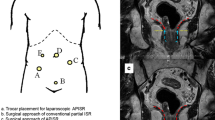Abstract
Background
Intersphincteric resection (IRS) is a surgical technique used to preserve sphincter function, mainly cases of low rectal cancer located less than 5 cm from the anal verge [1, 2]. There have been reports of laparoscopic ISR [3, 4], but discussion of the specific techniques used in this laparoscopic surgical procedure have not been sufficient. For better outcomes of this sophisticated procedure, extreme care must taken to prevent perforation of the rectal wall and to preserve the external sphincter muscle. The most difficult steps for ISR are the circular dissection and separation of the internal sphincter muscle from the external sphincter and puborectalis using the perineal approach. The authors’ techniques and the advantages of laparoscopic ISR are shown by a video presentation of three rectal tumor cases. Also, the perioperative outcomes for the patients who underwent laparoscopic ISR with this technique are described.
Methods
From January 2006 to September 2009, laparoscopic ISR with total mesorectal excision was performed for 15 patients (10 men and 5 women). The median age of the patients was 60.5 years. The T categories of the tumor node metastasis (TNM) classification for the rectal cancers were Tis for two patients, T1 for one patient, T2 for four patients, and T3 for eight patients. The median distance from the anal verge to the tumor in this series was 3.7 cm. The Tis cases had large laterally spreading tumors that could not be removed by endoscopic submucosal dissection. The T1 case presented in the video had a small tumor just above the dentate line that had developed in the presence of chronic ulcerative colitis. Because this case required total proctocolectomy and ileal pouch anal anastomosis, local resection was not used (Table 1).
Cases
The 68-year-old man in case 1 had a large, laterally spreading rectal tumor. The 61-year-old man in case 2 had rectal cancer, with a tumor located 4 cm from the anal verge. Laparoscopic surgery was performed after neoadjuvant chemoradiotherapy. The 71-year-old woman in case 3 had T1 rectal cancer, with a tumor located just above the dentate line. After dissection of the intersphincteric space, the prolapsing technique was used.
Methods
In the male patients, the rectum with the mesorectum was first dissected to the anal hiatus, initially on the posterior side along the avascular plane. Second, Denonvilliers’ fascia was dissected, and the seminal vesicle was exposed. The third step was dissection of the lateral tissues followed by incision of Denonvilliers’ fascia with the rectal wall exposure and care taken not to injure the neurovascular bundle (Fig. 1). Along this dissection plane, the puborectalis could be reached and intersphincteric space entered from the lateral side of the rectal wall (Fig. 2). The final step was dissection of the hiatal ligament at the posterior side of the rectum. Nearly circular dissection of the intersphincteric space could be completed. The difficulties associated with the perineal approach were reduced by this abdominal approach, and the tumor could be exteriorized easily.

After incission of the Denonvilliers’ fascia at the lateral side of the seminal vesicle puborectalis muscle can be reached at the lateral side of the rectum.

Adhesion line between the puborectalis muscle and rectal wall is enposed. Intersphinecteric space can be entered along this dissection plane at the lateral side of the rectum.
Results
The mean duration of surgery was 386 min, and the mean blood loss was 108 ml. The mean postoperative hospital stay was 18 days. The diverting ileostomy was closed at a mean of 7.3 postoperative months. No remarkable perioperative complication was encountered (Table 2).
Conclusion
Laparoscopic ISR enabled reduction of the difficulties associated with the perineal approach. An advantage of laparoscopic ISR is the ability clearly to visualize anatomic structures in the deep pelvic cavity.
Similar content being viewed by others
References
Schiessel R, Novi G, Holzer B et al (2005) Technique and long-term results of intersphincteric resection for low rectal cancer. Dis Colon Rectum 48:1858–1865 (discussion 1865–1867)
Saito N, Moriya Y, Shirouzu K et al (2006) Intersphincteric resection in patients with very low rectal cancer: a review of the Japanese experience. Dis Colon Rectum 49:S13–S22
Orsenigo E, Di Palo S, Vignali A et al (2007) Laparoscopic intersphincteric resection for low rectal cancer. Surg Oncol 16(Suppl 1):S117–S120
Uchikoshi F, Nishida T, Ueshima S et al (2006) Laparoscope-assisted anal sphincter-preserving operation preceded by transanal procedure. Tech Coloproctol 10:5–9
Disclosures
Madoka Hamada, Tomonori Matsumura, Tomoko Matsumoto, Fuminori Teraishi, Kazuhide Ozaki, Toshio Nakamura, Yasuo Fukui, Yutaka Nishioka, Toshikatu Taniki, and Tadashi Horimihave no conflicts of interest or financial ties to disclose in this study.
Author information
Authors and Affiliations
Corresponding author
Electronic supplementary material
Below is the link to the electronic supplementary material.
Supplementary material 1 (MOV 35559 kb)
Rights and permissions
About this article
Cite this article
Hamada, M., Matsumura, T., Matsumoto, T. et al. Advantages of the laparoscopic approach for intersphincteric resection. Surg Endosc 25, 1661–1663 (2011). https://doi.org/10.1007/s00464-010-1451-x
Received:
Accepted:
Published:
Issue Date:
DOI: https://doi.org/10.1007/s00464-010-1451-x




